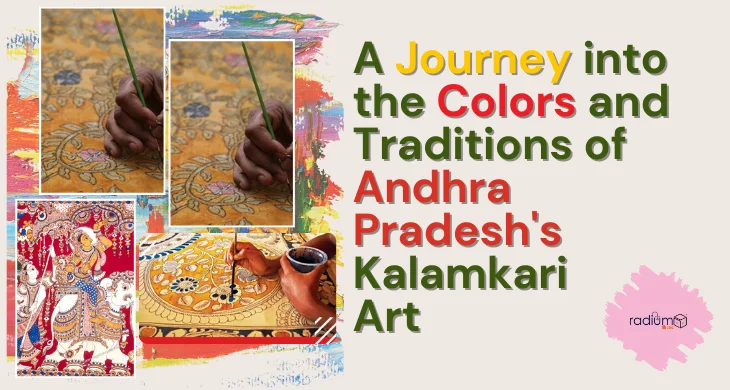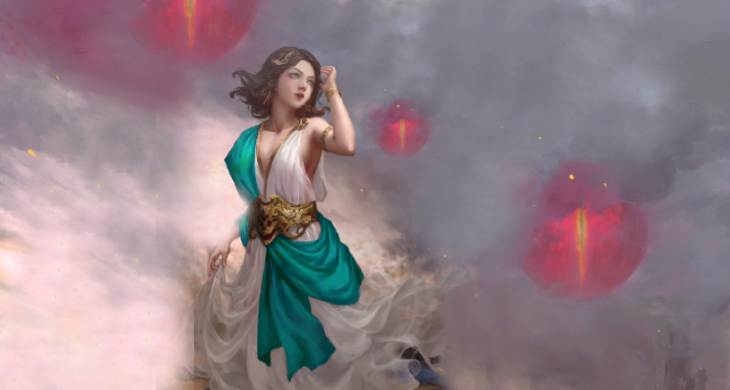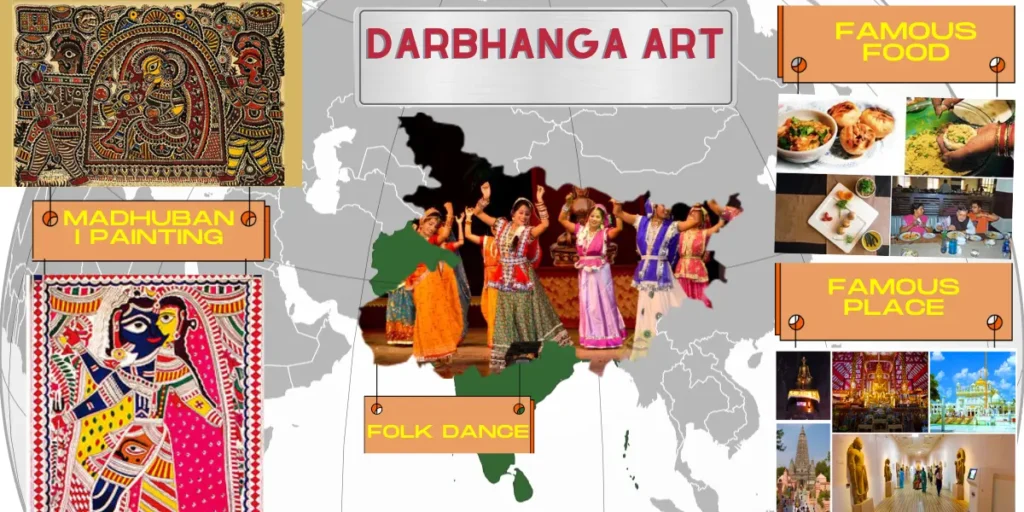The world of art is as diverse as the colors it embodies. In the culturally rich state of Andhra Pradesh, India, there exists an art form that is not only visually captivating but also deeply rooted in tradition and heritage. Welcome to the enchanting world of Kalamkari art, where vibrant hues and intricate designs come together to tell stories of ancient craftsmanship and artistic expression.
Origins and History of Kalamkari Art:
Kalamkari’s Ancient Beginnings
The history of Kalamkari art dates back to ancient times, with its roots entrenched in the rich soil of Indian heritage. The word “Kalamkari” itself is derived from two Persian words: “kalam,” meaning pen or brush, and “kari,” meaning craftsmanship. This art form is aptly named, as it involves intricate craftsmanship using brushes and pens.
Historical Traces
Kalamkari’s historical journey can be traced as far back as the Indus Valley Civilization, where evidence of painted and dyed fabrics has been discovered. However, it gained prominence in the Indian subcontinent during the medieval period, particularly in the southern regions, including Andhra Pradesh.
Andhra Pradesh: The Heartland of Kalamkari
Andhra Pradesh, with its ancient temples and rich cultural heritage, emerged as the epicenter of Kalamkari art. The art form found patronage in the courts of the Vijayanagara and Golconda kingdoms, further contributing to its growth and refinement.
Secrets Behind Kalamkari’s Artistic Techniques
Kalamkari’s Unique Process
Kalamkari art’s allure lies not only in its intricate designs but also in the unique and meticulous techniques used to bring those designs to life. Let’s unveil the secrets behind Kalamkari’s artistic process, which combines age-old traditions with contemporary creativity.
Tools of the Trade
At the heart of Kalamkari art are the tools: the kalam (pen) and the kalamkari (craftsmanship). Artisans craft these tools with precision, ensuring that they are perfectly suited to the intricate work they will create. The kalam is typically made from bamboo, which is split into fine nibs to create various line thicknesses.
Pigments from Nature
One of Kalamkari’s unique aspects is its use of natural dyes, which are derived from plants and minerals. These pigments are mixed with water and applied to fabric in an intricate layering process. Some common natural dyes include indigo, madder root, myrobalan, and iron acetate, each offering a distinct color palette.
Resist and Dye
A defining technique in Kalamkari art is the resist-dye method. This involves creating intricate outlines of designs on fabric using the kalam. To prevent colors from blending, the artisans apply a resist paste made from molasses and natural substances like clay and seeds. This paste acts as a barrier, ensuring that dyes are absorbed only where intended.
Vegetable Block Printing
In the Machilipatnam style of Kalamkari, wooden blocks play a pivotal role. These blocks, intricately carved with designs, are used to create patterns on fabric. The artisan dips the block in natural dye and presses it onto the fabric, leaving behind a beautiful and symmetrical design.
Multiple Layers of Detail
Kalamkari art is known for its remarkable attention to detail. Artisans often apply multiple layers of colors, allowing each layer to dry before adding the next. This painstaking process results in the vibrant and complex designs that are a hallmark of Kalamkari.
The Fusion of Tradition and Modernity
Today, Kalamkari artisans continue to uphold these traditional techniques while also embracing contemporary influences. The art form has found a global audience, with modern designs and adaptations making their mark in the world of fashion and home decor.
Mythological Themes in Kalamkari Art
Kalamkari’s Mythical Canvas
Kalamkari art, deeply rooted in Indian culture and heritage, is often a canvas for mythological narratives and spiritual stories. In this chapter, we embark on a journey through the rich mythological themes that grace the fabric of Kalamkari art.
Stories from Hindu Epics
Many Kalamkari designs draw inspiration from Hindu epics like the Ramayana and the Mahabharata. These epic tales provide a vast reservoir of characters and stories that artists beautifully depict on fabric. Scenes from Lord Rama’s exile, the Pandavas’ trials, and the adventures of Lord Krishna frequently grace Kalamkari textiles.
Gods and Goddesses
The pantheon of Hindu deities serves as a prominent source of inspiration in Kalamkari art. Artists skillfully portray gods like Lord Shiva, Lord Vishnu, Goddess Lakshmi, and Goddess Durga, each with their unique attributes and symbolism. These divine depictions not only showcase the artists’ reverence but also infuse spiritual energy into the fabric.
Preserving a Cultural Heritage through Kalamkari Art
Kalamkari: A Cultural Treasure
In this chapter, we delve into the vital role played by Kalamkari art in preserving and promoting India’s rich cultural heritage. Kalamkari isn’t just an art form; it’s a repository of tradition, history, and cultural identity.
Art as a Chronicle
Kalamkari art serves as a living chronicle of India’s past. The intricate patterns, motifs, and narratives on Kalamkari textiles carry the stories of bygone eras, dynasties, and civilizations. From the grandeur of Mughal courts to the simplicity of village life, Kalamkari captures it all with remarkable artistry.
Passing Down the Legacy
Kalamkari is an art form that’s been handed down through generations. Artisans, often from families with centuries-old traditions, continue to practice and teach the craft to their descendants. This passing down of knowledge ensures that the legacy of Kalamkari remains vibrant and intact.
Revival and Recognition
Over the years, there has been a concerted effort to revive and promote Kalamkari art. Artisans and organizations have worked tirelessly to ensure that this heritage doesn’t fade away. The recognition and patronage that Kalamkari has received on national and international stages have bolstered its survival.
FAQS:
Ques: What is Kalamkari art?
Ans: Kalamkari is a traditional Indian art form that involves hand-painting or block-printing intricate designs on fabric. It’s renowned for its vibrant colors and detailed storytelling.
Ques: Where did Kalamkari art originate?
Ans: Kalamkari has its roots in the Indian states of Andhra Pradesh and Telangana. The art form has a history dating back centuries.
Ques: What are the distinctive features of Kalamkari art?
Ans: Kalamkari art is known for its use of natural dyes, intricate motifs, and elaborate narratives inspired by mythology, nature, and historical events.
Ques: What are the two main styles of Kalamkari art?
There are two primary styles: Srikalahasti and Machilipatnam. Srikalahasti Kalamkari is freehand drawing using a pen (kalam), while Machilipatnam Kalamkari involves block printing and is often more colorful.
Ques: What types of products are made using Kalamkari art?
Ans: Kalamkari is used to create a wide range of products, including sarees, garments, wall hangings, bedspreads, and accessories like bags and scarves.
Conclusion:
As we conclude our journey, let us celebrate the artisans who continue to paint the fabric of history with their skill and passion. May the colors and traditions of Andhra Pradesh’s Kalamkari art continue to flourish, weaving tales of beauty, culture, and creativity for generations to come.




